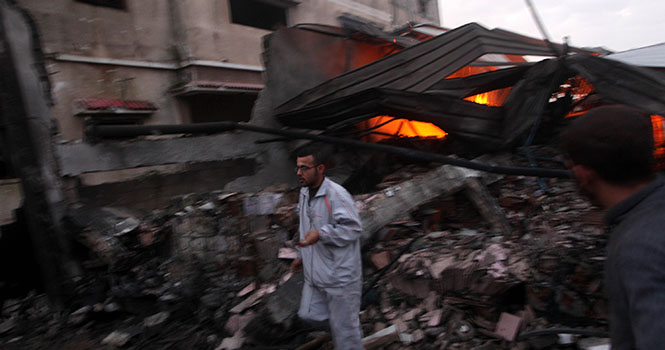Gaza cease-fire raises hopes for reconstruction
Palestinians try to extinguish a fire following an Israeli strike in Zeitun, on the outskirts of Gaza City, on Saturday, November 17, 2012. Israeli aircraft bombed Hamas government buildings in Gaza on Saturday, including the prime minister’s office, ahead of a possible ground invasion. Photo courtesy of MCT Campus.
November 25, 2012
SARAH EL DEEB, Associated Press
GAZA CITY, Gaza Strip (AP) — Mohammed Falah Azzam has been through this before.
His mother’s home was bombed in the 2008-09 Israeli military offensive in the Gaza Strip, which left hundreds dead and thousands of homes destroyed. In renewed fighting last week, an entire block of buildings housing his extended family was badly damaged in an airstrike that Israel said was aimed at a militant.
While none of his relatives were hurt, the 61-year-old retired schoolteacher once again has to worry about providing shelter for his family. Some relatives are sleeping in an empty shop, squeezed in with other family members. Others are spending their nights in rooms covered in plastic wrap to shield them from the winter rain because all the windows were blown out.
“This is going to cost thousands,” Azzam said. “The longer I wait, the more damage will happen,” he added, pointing to a heavily damaged building sitting atop tilting concrete columns.
Azzam finds himself caught again in a pile of paperwork to seek assistance, trying to secure hard-to-get construction materials. This time, he hopes the process will be smoother, thanks to both Israel’s pledges to ease its longstanding border blockade and the newfound political clout of Gaza’s Hamas rulers in the region.
Israel promised to ease the blockade as part of a cease-fire last week that ended eight days of intense fighting. But difficult negotiations lie ahead, and there is no firm timeline for lifting the restrictions.
Israel launched its offensive Nov. 14 in response to months of rocket fire out of Gaza. It carried out some 1,500 airstrikes during the fighting, while Palestinian militants lobbed a similar number of rockets into Israel.
The damage to buildings in Gaza appears less extensive than it was four years ago. The United Nations estimates 10,000 homes were destroyed or damaged, while Hamas has put the number at about 8,000, including 500 that were destroyed or heavily damaged. In comparison, U.N. relief agencies said as many as 40,000 homes were affected in the earlier round of fighting.
Israel says its airstrikes are aimed at militants, and it blames Hamas for the damage, accusing the group of using residential areas for cover.
Reconstruction since the 2008-09 fighting has been slow, in large part because of Israel’s blockade. Israel imposed the restrictions in 2007, after Hamas, a militant group sworn to its destruction, wrested power over the coastal strip from the government of Western-backed Palestinian President Mahmoud Abbas.
Under international pressure, Israel loosened the blockade in 2010 but maintained tight restrictions on imports of glass, cement, metal and other construction materials, saying they could be diverted for military use. Only U.N agencies and international organizations in the Palestinian territory are allowed to import such material from Israel for their own projects.
To make up the shortage, a bustling smuggling industry through underground tunnels along the Egyptian border has sprung up. While prices for key construction goods have come down, they still remain expensive for the majority of the population in Gaza, where the unemployment rate is over 30 percent and 80 percent of the people rely on U.N. handouts.
“The blockade in terms of housing impacts us primarily — the U.N. —and the people who are most vulnerable who don’t have access to jobs or economic opportunity,” said Scott Anderson, deputy director of the U.N. Relief and Works Agency. “People who have money, it is easily available.”
In the short term, there is no relief in sight. During the recent offensive, Israel heavily targeted the tunnels, which are also used to bring weapons into Gaza. Residents along the border say that smugglers and tunnel owners are still inspecting the damage but that many of the tunnels still operate, though at reduced capacity.
An Egyptian security official, speaking on condition of anonymity because he was not authorized to talk to the media, estimated that half the tunnels are not functioning.












